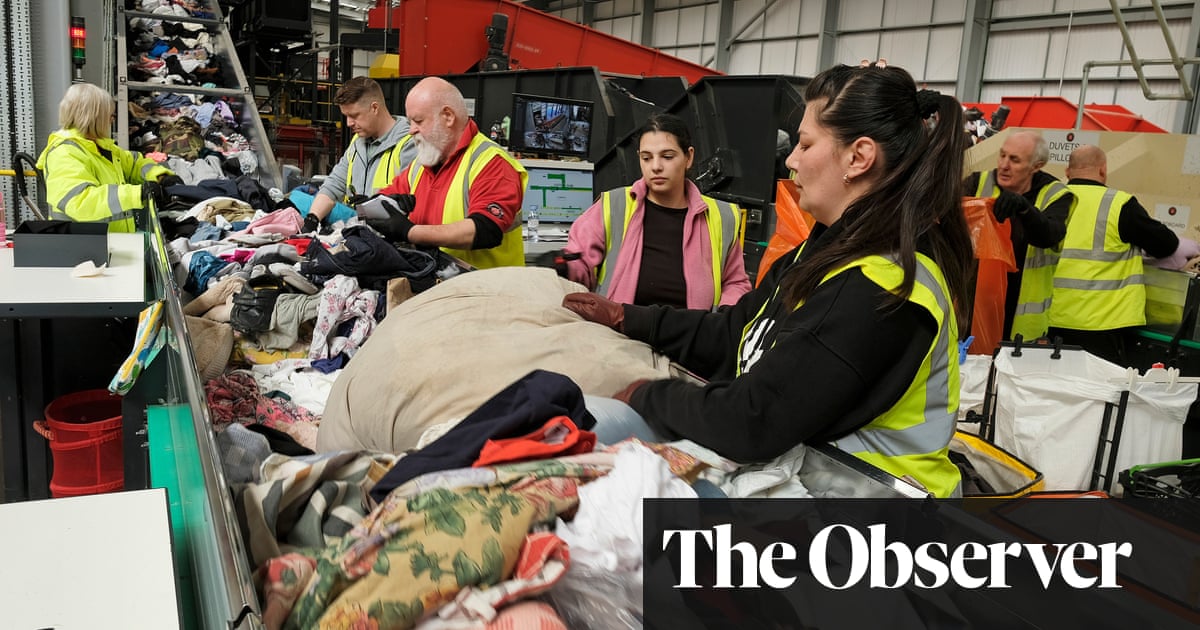Bussiness
‘A world first’: project recycles polyester into yarn for new clothes

Football shirts, sports event banners and uniforms are piled up ready to be pumped into a machine which melts them down for recycling ready to be made into new clothes.
In a world first in Kettering, Northamptonshire, Project Re:claim is taking technology used for recycling plastic bottles and adapting it to reprocess polyester textiles into granules that can be turned back into yarn for new clothes.
The joint venture between the Salvation Army and recycling specialist Project Plan B uses items from the charity’s sorting centre, which separates out the 10-20% of donated items that cannot be resold according to type of textile. Infrared sensors pick out wool, cotton and nylon items that can be sent off to experimental reprocessors and yarn makers around the world – including polyester for the pellet-making machine.
Project Re:claim expects to recycle 2,500 tonnes of waste this year and to double that in 2025. It is working with big retailers, including Tesco and John Lewis, as well as specialist manufacturers such as school uniform maker David Luke, which encourage suppliers to use the recycled polyester.
The venture, partly funded by a government-backed grant, is part of a movement aimed at tackling the enormous pile of unwanted and unwearable clothing that is sent to landfill or for incineration every year, and the high carbon emissions of the fashion industry.
In the UK, about half of the 1.45m tonnes of used textiles generated annually ends up in the household bin and is mostly incinerated, according to a report by the government recycling body, Wrap. A further 650,000 tonnes is sent for reuse or recycling but most of that goes into making products such as fillings for mattresses or car doors, which are also likely to end up in landfill. Just 20% of used textiles is sold for clothing.
More than 420,000 tonnes of unwanted items are sent overseas, where they can end their days in unregulated landfill or strewn across the beaches of Ghana and the dunes of the Atacama desert in Chile.
The industry has been slow to tackle the problem, with some projects brewing for more than a decade and one major facility recently going bust. However, industry watchers say now the used-textiles-to-yarn industry is set for rapid expansion as legislation and consumer pressure combine to force major retailers to act.
“I’m expecting rapid change from this point,”ays Prof Parik Goswami, director of the technical textiles research centre at the University of Huddersfield. “Over the next 10 years we will see an absolute revolution.”
Countries in Africa and Asia that once accepted used clothing from the west are pushing back, while retailers’ environmental targets, created under pressure from customers, have begun to loom large. Change has been accelerated by EU legislation, due next year, under which states must organise separate textile collection, and a proposal for brands to pay for handling waste. France and the Netherlands are already bringing in stringent measures on the handling of used textiles.
In the UK, MPs last month began re-examining plans requiring retailers and brands to pay towards the recycling of used clothing and household textiles. That would be a step on from voluntary agreements already in place, which include the Textiles 2030 deal to reduce carbon emissions and the ACT UK project to develop locally based material recycling.
Marks & Spencer kicked off a new initiative with Oxfam under which it is asking for donations of unwearable items for reprocessing. It plans for at least some of those items to be recyled into new textiles and others to be upcycled, but full details have not been confirmed.
Earlier this month, H&M told MPs it was aiming for half of its materials to be recycled by 2030 – up from just over a fifth at present. It wants all of its polyester to be recycled, up from just under 80% last year. That polyester all comes from plastic bottles at present, but the company has formed a joint venture, Syre, which it says will set up a blueprint polyester textile recycling centre in the US this year and 11 more by 2032.
Making old clothes into yarn is not new: shoddy was the name of the wool cloth made from yarn spun from shredded textiles in the 1800s. In 2011, M&S worked with Oxfam and a mill in Italy to collect and reprocess cashmere knitwear to be remade into coats, but the trial quietly ended after it could not find enough unwanted knitwear to reprocess.
Today, many hi-tech options are springing up around the world. Forestry group Södra in Sweden turns a mix of used cotton and wood pulp into fibre; Recover in Spain recycles used cotton fibres into yarn and has recently expanded with a new facility in Bangladesh while German chemical maker BASF has teamed up with Zara owner Inditex to trial recycling nylon. Finland’s Infinited Fiber, which has trial plants turning cotton into a cellulose-based fibre, recently raised $43m (£34m) to help build a commercial scale plant.
Coming full circle, in Yorkshire, the wool recycling firm iinouiio (It Is Never Over Until It Is Over) began by using traditional equipment once used to make shoddy to recycle luxury woollen yarns in 2019. In 2022, it partnered with Camira, a global fabric manufacturer, to provide wool recycling to retailers and is taking textiles from the Salvation Army.
However, progress may not be easy. The future of Renewcell in Sweden – the world’s first commercial-scale recycling plant that turns textiles into to pulp ready for thread – hangs in the balance. The company called in administrators in February after being undercut by a fall in the price of virgin viscose. Administrators are considering two or three bids for the company and are hopeful of securing a deal as a going concern.
Renewcell’s troubles highlight the difficulties such experimental technologies face in securing enough finance to overcome glitches in a very complex supply chain and competition from often cheaper virgin materials.
Textile-to-textile recycling needs a reliable supply of used textiles processed to reduce contamination, a yarnmaker ready to buy the recycled material and fabric, and clothing brands prepared to use a product which may not meet the criteria of materials they usually work with.
Back in Kettering, they are battling with all those challenges. Majonne Frost, head of environment and sustainability at the Salvation Army Trading Company, says it has been trialling different kinds of feedstock – from sports kit to hospital curtains – for the Re:claim recycling machines. It has also spent time persuading brands and manufacturers to change buttons and trims so a uniform, for example, is made entirely from polyester and can be put into the machine without the need for complex processing.
Challenges vary from dealing with contamination such as human hair – which can tint the granules, making them less easy to dye to any colour – to the additional costs involved in shipping the granules back to yarn spinners, which are usually based in Asia or, at the nearest, Turkey.
“We are developing the market. This is a world-first technology and people are not used to using this product, so it is about making companies aware and collaborating to get recycled polyester built into their supply chains,” she says. “Lots of conversations are happening.”
Goswami says that the technology is there to process used clothing and what is needed is cooperation and investment to make things happen.
“People are serious about it,” he says. “If we are going to [achieve] net zero, we don’t have much option.”








